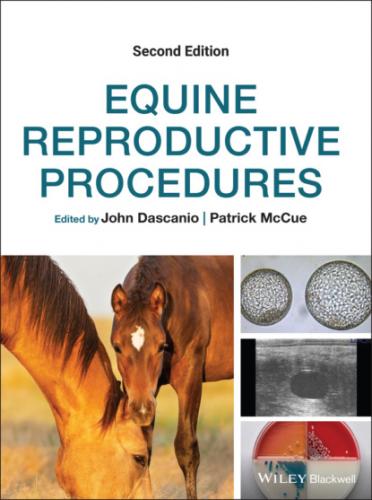Using a slight rotating motion, pass the hand into the vagina so that the mid‐forearm is to about the level of the vulva. This should enable palpation of the external cervical os.Figure 12.1 Kalayjian swab in the open position.Figure 12.2 McCullough swab in the open position.
Gently insert the index finger into the external cervical os. Sometimes the os may be off center, located slightly downward, or to the left or right of center.
Pass the index finger through the cervix to the last knuckle (metacarpo‐phalangeal joint). Usually one can detect when the fingertip enters the uterine body lumen. Pass the uterine culture instrument past the inserted index finger into the uterine body. Sometimes, if the cervical canal is under the influence of progesterone and is toned, the index finger may need to be removed prior to passing the culture device. The culture instrument may need to be pointed in a slightly downward direction when being passed through the cervix due to the dependent nature of the suspended uterus within the abdomen, especially in older broodmares.
As most culture devices used today have a guard over the inserted end, the inner swab/brush is subsequently pushed forward through the cap/guard.Figure 12.3 Uterine brush in the open position.
Gently press the swab or brush in contact with the endometrium and gently rotate in one direction. It is recommended that the swab/brush be in contact with the endometrium for 10–15 seconds.
The swab/brush is retracted back inside the outer guards and then the device is removed from the mare. Care should be taken when rotating the swab as excessive motion can result in breaking of the end of the swab (Figure 12.4).
Once the culture instrument has been withdrawn from the external cervical os, a cupped hand should be placed over the device to limit vaginal contamination to the swab/brush.
The swab should be immediately plated or transferred to a transport device with media such as a CultureSwab™ (Figure 12.5). Often the outer swab guard is removed from the inner guard before extending the swab/brush into a transport device to limit contamination from the outer guard.
Figure 12.4 Tip of a uterine culture instrument broken off in the uterine lumen.
Figure 12.5 Transport device for uterine cultures.
Interpretation
In mares with a dependent uterus, well over the brim of the pelvis, the swab may be subjected to the downward weight of the uterus, making breakage of the tip of the swab more likely. Breakage of the swab tip may occur particularly when the swab is rotated, thus caution should be used.
Note any discharge present on the sterile sleeve when the gloved arm is pulled from the vagina. There should not be any purulent or hemorrhagic discharge, only the lubricant and clear mucous should be present.
Ensure that the culture device is intact and that no part of the instrument was left within the mare's uterus/cervix/vagina.
Note any discharge on the tip of the culture device. It is not uncommon to see some mild hemorrhage on the culture device as it rubbed against the endometrium.
The most common pathogens of the equine uterus are Streptococcus equi subspecies zooepidemicus, Escherichia coli, Klebsiella species, Pseudomonas aeruginosa, and fungi, among others.
Heavy growth of one organism may have more significance than light growth of multiple organisms.
Uterine culture results should be correlated with uterine cytology and other reproductive findings to determine significance.
Further Reading
1 Hinrichs K, Cummings MR, Sertich, PL, Kenney RM. 1988. Clinical significance of aerobic bacterial flora of the uterus, vagina, vestibule, and clitoral fossa of clinically normal mares. J Am Vet Med Assoc 193(1): 72–5.
2 LeBlanc MM. 2010. Advances in the diagnosis and treatment of chronic infections and post‐mating induced endometritis in the mare. Reprod Dom Anim 45(suppl. 2): 21–7.
3 Nielsen JM. 2005. Endometritis in the mare: a diagnostic study comparing cultures from swab and biopsy. Theriogenology 64(3): 510–18.
13 Antimicrobiotic Sensitivity Testing
Jillian Bishop1 and Patrick M. McCue2
1 University of Kansas Health System, USA
2 Equine Reproduction Laboratory, Colorado State University, USA
Introduction
A Kirby–Bauer disk diffusion susceptibility test (agar disk diffusion test) is used to evaluate the effectiveness of specific antibiotics against aerobic bacterial organisms under in vitro culture conditions. A known quantity of bacteria are distributed evenly on the surface of the agar plate and a series of paper disks, each impregnated with one antibiotic, are placed on the surface of the agar plate. The zone of growth inhibition around each test disk is a measure of the sensitivity of the organism to the given antibiotic.
Equipment and Supplies
Mueller Hinton (MH) II agar plate: MH‐II agar plates with 5% sheep blood for Gram‐positive β‐hemolytic organisms, MH‐II agar plates without sheep blood for Gram‐negative organisms; sterile swab; antibiotic disk dispenser; antibiotic sensitivity disks: ampicillin 10 μg, amikacin 10 μg, ceftiofur 30 μg, enrofloxacin 5 μg, gentamicin 10 μg, penicillin G 10 units, trimethoprim/sulfamethoxazole 23.75/1.25 μg, ticarcillin 75 μg with clavulanic acid; incubator; measuring device.
Technique
Allow a Mueller Hinton (MH) II agar plate to equilibrate to room temperature. Label the plastic dish bottom (agar side) with the mare’s name, source of sample, and date.
If the bacterium of interest is Gram‐positive and β‐hemolytic, use a MH‐II agar plate with 5% sheep’s blood in order to visualize the colorless colonies and zones of inhibition (e.g., Streptococcus equi subspecies zooepidemicus).
Option 1 for inoculating the MH‐II agar plate:Use a single cotton swab to pick up one to three isolated identical colonies from the original culture plate.Streak the MH‐II agar plate in a painting fashion until the entire plate has been swabbed with the bacteria (Figure 13.1). An example would be:streak three parallel lines down the center of the platestreak the entire plate going perpendicular to the primary three lines; try to cover the entire platerotate the plate 90 degrees and streak the entire plate
